 |
  |
 |
  |
Celebrating 100 years of Yog Sunder Desai A Century of Life and Dance - Papiha Desai e-mail: papihadesai@gmail.com Photos courtesy: Papiha Desai July 10, 2021 Yog Sunder Desai, a pioneer who ventured into the world of Indian Dance in the pre independence era, was born on July 16, 1921 in Limbdi, Gujarat into a princely family of Gujarat. July 16, 2021 is his Birth Centenary. In his 100th year of life in 2020, Yog Sunder was the senior most living artiste and choreographer of India. His maternal grandfather Jhaverbhai Amin was the Diwan of Limbdi state and his paternal grandfather Ambaidas Jeevabhai's ancestors were the administrators of the Mughals and the Gaekwads. Yog Sunder was born to illustrious parents Bhaktiba, a freedom fighter and Darbar Gopaldas, the ruler of Dhasa State in Gujarat, the first Indian prince to give up his throne in response to Gandhi's call to serve the motherland and join the freedom movement. Darbar Saheb as he was addressed became a prominent leader of Gujarat, leading the masses with the Sardar in Borsad and Bardoli Satyagrahas, Salt Satyagraha and the Quit India movement. President of Kathiawad Rajkiya Parishad and Saurashtra Congress Committee, Gopaldas worked for the unification of the 200 plus states of Kathiawad - Ekam Saurashtra. He was the first prince in India to merge his principality with the Indian Union and one of the first members of the Constituent Assembly of India. The constitution of India bears his signature. 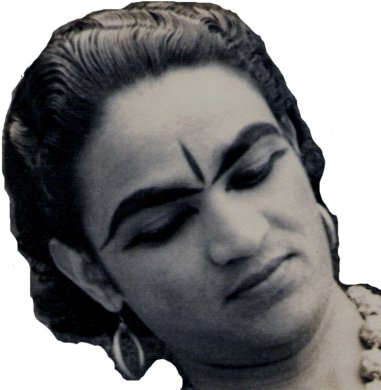
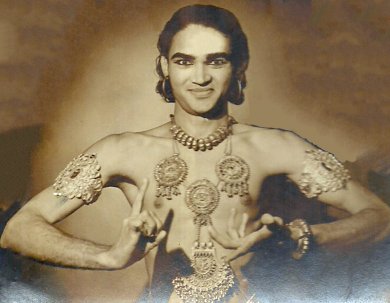
A product of national cultural institutions (Rashtriya Shaalas) like Dakshinamurthy, Gujarat Vidyapeeth and Tagore's Shantiniketan, Yog Sunder had a privileged upbringing spent under the guidance of Gandhiji, Sardar Patel and Rabindranath Tagore. He went to Bardoli Ashram at the age of five during the Bardoli Satyagraha and participated in the freedom movement as a member of Vanar Sena in Borsad Chhaoni, participated in the Satyagrahas, distributing Satyagraha patrikas. He was a Swayam Sevak at Haripura Congress session of 1938, presided over by Subhash Chandra Bose, where his father was the President of the reception committee. He joined Rajkot Satyagraha as a student of Dakshinamurthy and later, the 1942 Quit India movement. In Shantiniketan he learnt painting under the legendary Nand Lal Bose in Kala Bhawan and Manipuri dance from Guru H Atomba Singh and Rabindra Sangeet from Santidev Ghose. Yog Sunder trained in Kathakali under Guru Kelu Nair in Shantiniketan and under Guru Vazhenkada Kunchu Nair in Kerala, where he lived with his Guru for many years. He learnt Krishnattam from Krishna Kartav and Mohiniattam from Kochumalu Amma in Kerala. He is the first non-Malayali to have undergone full rigorous training in Kathakali. Yogendra Sunder as he was known then, debuted on the Bombay stage as Raja Bhim Dev in KM Munshi's 'Jai Somnath' in 1945 with Nayana Jhaveri as Chauladevi. "I would always remain interested in your activities," said KM Munshi, the founder of Bharatiya Vidya Bhawan. During this period, Yog Sunder performed in several productions of the Indian National Theatre and Gujarati adaptations of Tagore's 'Chandalika' and 'Tasher Desh' (Patta No Pradesh). The legendary Ram Gopal of Bangalore invited him to join his troupe which toured undivded India including Lahore and Karachi in 1946 and Yogendra established himself as an outstanding Kathakali dancer. "His art is full of rich promise and power", said Ram Gopal. He learnt Kathak from Pt. Bhure Lal. Yogendra Sunder started the Indian Progressive Ballet Group in Calcutta in 1947 and ran the Group on a cooperative basis successfully and produced well reputed programmes. The first show in Kalika theatre was a house full show. The brochure was designed by the celebrated Satyajit Ray who was a fellow student in Shantiniketan. Yogendra Sunder partnered the renowned dancer and film actress and the daughter of Keshav Chandra Sen (founder of Brahmo Samaj), Sadhona Bose in 'Abhisar' (or Vasavadatta), based on Tagore's poem, where Yogendra played the Buddhist monk Upagupta with Sadhona's Vasavadutta. Yogendra played the roles of Rama in Ramayana and Krishna in Geet Govind with a group called 'Mystic Dancers of India.' Yog Sunder founded his dance ensemble in 1948 in Calcutta and called it the Indian Revival Group in the spirit of revivalism that was sweeping the country. One of the foremost dance ensembles in India which has to its credit a glorious record of achievements, the Group has completed over 70 years of its unbroken chain of existence, dedicated to the cause of furthering the rich multi-cultural heritage, mythology, philosophy and glory of India. 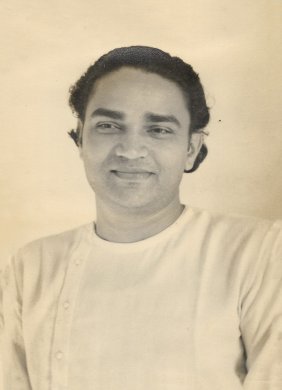
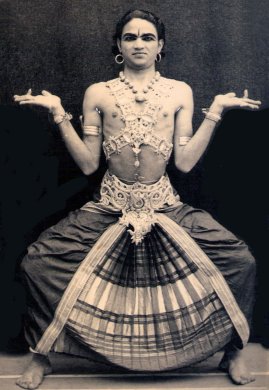
The first production of Indian Revival Group 'Freedom Festival' premiered on August 15, 1948. This production was followed by 'Birth of freedom' presented on Gandhi Jayanti in 1949 followed by 'Ajanta'. 'Mahabharata' in silhouette and shadow was presented in Purna Kumbh Mela, Hardwar in 1950 so that maximum people could witness at minimum cost. Yog Sunder was the producer-director and Arjuna. Indian Revival Group has produced and presented a number of memorable ballets and dance programmes incorporating different styles and techniques of dance with appeal to the masses and classes alike. In 1954, the Group's first tour abroad to Egypt, through the Indian National Theatre in Bombay to perform on a chartered cruise ship 'SS Independence' was a raving success. The Group was received by the then President of Egypt, General Naguib, when it performed in Cairo and its programme received rave reviews in the Egyptian press with front page news and photographs such as -" Difficult to describe in words....Those who have not seen it, cannot imagine what they have missed" - Les Progress Egyptienne. " Had we not seen it ourselves, we would have never believed it and would have thought it a legend" - Al Musawar (Cairo), "This disciple of Lord Shiva displays such a variety of looks, arm, and head movements, attitudes." -Les Progress Egyptienne (Cairo), "Most remarkable since Mrinalini Sarabhal passed through Cairo... exceptionally well received by audience...It is greatly to be hoped that the show would be restaged for a larger public...may we emphasize that such a charm should not be reserved to a limited audience" - La Bourse Egyptienne (Cairo), "Nothing was missing...What talent, What brio, What Spirit, What animation" - S. Liliane (French art critic), "A show of Uday Shankar's prestige" - Images (French Weekly), "Felt spell-bound. We all Egyptians have to admit the greatness of Indian art" - Akhere-Baat (Cairo). "Everybody was wonderstruck by their pleasing and charming movements....... Cairo was fortunate enough to enjoy their typical art of Indian dancing." - Al Misri. In 1955, Yog Sunder produced 'Rhythms of India,' a spectacle of India's rich and varied dance heritage that has stood the test of time and remained ever popular, evolving in the last 70 years. The show went on All-India Tours in 1955 and 1956 which lasted for over ten months each. The National Press applauded and described the performances as - "Great vivacity.....Admirably choreographed... Eye catching.... Excitement packed.....happily blended to capture the spirit of the people.....lovers of beautiful ballets are advised not to miss it....So thrilling... interest never waned.....Spell bound ......If a continued silence was broken at all, it was by loud cheers at the conclusion of each item....drew full-throated praise... Striking..... Cast a spell over the spectators....Wonder struck!" Inspired by Gandhian ideologies, Yog Sunder has taken art to the masses, performing more than 5000 shows and dance experiments and conducted more than 500 tours through the length and breadth of the country, before over fifty lakh spectators and travelled over five lakh kilometres, which is an unprecedented achievement and record in the history of the country. Yog Sunder met young AJ Jaspal at the Gaiety Theatre in Simla in 1955 and brought him to Delhi, establishing him as the Head of the Cultural Wing of Hotel Ashok. Jaspal went on to become a well-known Impresario and was instrumental in building the careers of many famous dancers of India. 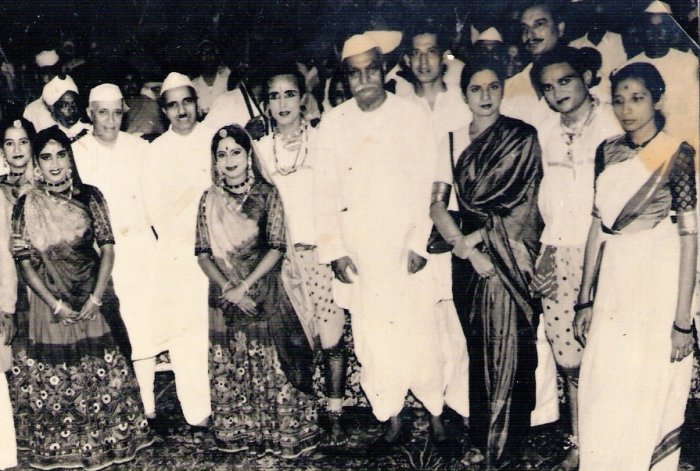 Yog Sunder and Indian Revival Group with Dr. Rajendra Prasad & Pt. Nehru 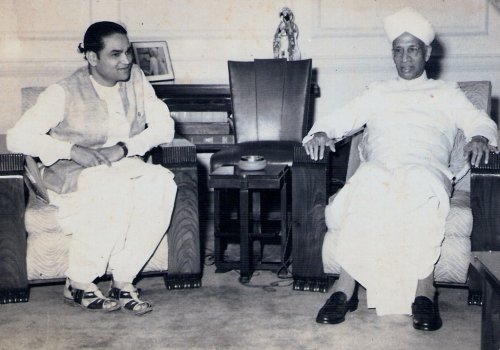 Yog Sunder with Dr. S. Radhakrishnan IRG performed at the First Command Performance at Rashtrapati Bhawan before the first President, Dr. Rajendra Prasad and first Prime Minister, Pt. Nehru in 1957. Subsequently, IRG performed for Dr. S. Radhakrishnan, Lal Bahadur Shastri, Indira Gandhi and many international leaders and heads of state at Rashtrapati Bhavan and abroad. In fact the Group has had the privilege to perform before every Prime Minister and President of India several times. In 1957, Yogendra Sunder visited Russia. The Group was one of the three cultural troupes selected by the Government of India to represent India at the Sixth World Youth Festival held at Moscow in 1957. The Group's programme was so popular that there were requests for the extension of its stay and to perform in other parts of the country. Of the 100 troupes from different countries this Group was the only one presented on Moscow Television four times. "Most expressive adjectives of praise are unworthy of expression for this magnificent and most impressive representation." "Yogendra Sunder's Peacock, thrilled the audiences....It had three recalls," said Veeherny (Leningrad). IRG recorded the first dance program for Doordarshan. In 1959-1960, Yog Sunder undertook the most adventurous tour of the Middle East by land route via Afghanistan, performing 100 shows in 7 countries in 7 months - Afghanistan, Iran, Iraq, Syria, Lebanon, Gaza, Egypt, and Kuwait. This was the first time any Indian dance troupe had gone to these countries. The tour was fuelled by the adventurous and enterprising spirit of Yog Sunder, who embarked on this tour without any prior booking in any country, and on a cooperative basis where all members of the group were equal partners. In Gaza, they performed for UN forces. The Press said, "The show brightened the end of the Iranian summer. How vivid how varied - Kayhan International (Tehran), "Most Impressive....Lovely....Attractive...Eye Catching" - Beirut Weekly, "Hearts of the Syrian danced with the Indian dance group and Indians wept out of joy," - Al Kifah (Damascus, Syria). Yog Sunder toured India In 1963 and Europe in 1964. The Group was sent by the Govt. to represent India in the International Folk Dance Festival in Istanbul and his group won an award...A two and a half month tour took them to perform in East Europe, Turkey, Hungary, Yugoslavia, Morocco and Cairo. The press showered appreciation in the following words - "The performance of Indian Group is the diamond of success in the crown of Festival" - Milliyet (Istanbul); "The show, as if we turn pages of a thousand coloured book of wonderful mystic tales"; "Art of Yog Sunder is not only known in India but in several countries of Europe now" - a Nokiapja (Budapest); "Yog Sunder showed well composed dances, strong rhythms, wide scale of expressiveness" - Politika (Belgrade, Yugoslavia). Indian Revival Group is one of the widest travelled groups in India. There is hardly any region that the Group has not visited. It has covered the length and breadth of India many times. It has undertaken long tours at times lasting over two years at a stretch. It has performed in towns and villages, valleys and hills for farmers and labourers, for workers in industrial areas, for students in schools, colleges and universities, for T.B. patients, for prisoners in jails and for the Indian Army and the Jawans guarding our borders, in remote interiors, in forward and border areas, in most difficult terrain and weather conditions, where no one dared to go. Endowed with an incredible spirit and enthusiasm, Yog Sunder undertook highly adventurous and strenuous tours to border areas in Ladakh and Arunachal Pradesh. The Group was the first to visit Ladakh in 1958 where it performed for the Jawans at an altitude of over 12,500 feet with the help of oxygen. The Group cherished the rewarding experience of undertaking the most challenging and toughest journeys in the Himalayas to reach difficult and snow covered places to perform for the Indian Army. Artists, wearing army boots and jackets, performed on make-shift stages on army trucks lit up with truck headlights! 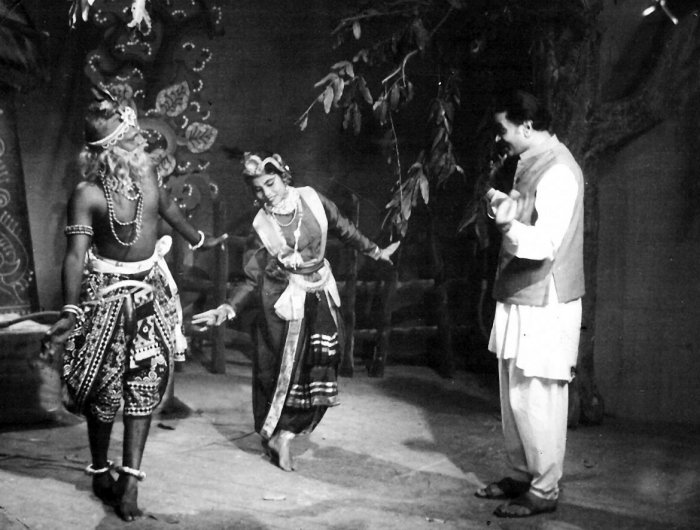 Yog Sunder directing Bharatiya Kala Kendra's Ram Lila Yog Sunder directed the 'Ram Lila' for Shriram Bharatiya Kala Kendra in 1966 and 'The Lore of Ind' for ITDC in1967. He received rave reviews for his work - "Ramlila ballet comes of age" (Patriot), "Kala Kendra's Improved Ramlila Ballet" (Times of India), "Kala Kendra drama impresses". His magnum opus titled 'The Man Divine' based on Tagore's poem, The Child, his one and only original English poem which was later translated in Bengali as 'Shishu Tirtha' is a tribute to both Gandhi and Tagore, the two men who influenced him and his work in life, produced in 1969 for Gandhiji's birth centenary at the behest of the then congress President UN Dhebar.The production was produced at a colossal scale bringing together masters like Jyotindra Maitra and Satish Bhatia of AIR for music score, Goverdhan Panchal of NSD for designing the sets, Malti Mehta for costumes and National School of Drama's Ram Gopal Bajaj, who wrote and gave voice to the Hindi commentary. Yog Sunder shifted his base to Delhi in 1970 bringing with him many dancers and musicians from Calcutta who went on to become well established artists of the capital. He helped build the career of many artists of Bombay, Calcutta and Delhi. In 1975, Yog Sunder directed 'Shyama' in Hindi which received rave reviews in Calcutta and toured England, Wales, Ireland and Scotland for Tagore's 125th Birth Anniversary in 1986. He was invited to participate in the First and Second Ballet Festival of Sangeet Natak Akademi, and presented productions on contemporary themes - 'The Journey' in 1976 and 'Darkness at Noon' in 1977. In the eighties, he created 'Ram Katha' assimilating the folk theatre traditions and storytelling techniques of India where Nat and Nati narrate the story employing the technique of Rangla and Rangli of 'Bhawai', the folk theatre of Gujarat. Yog Sunder led the Group to Tanzania, Kenya, Jordan, Oman, Bahrain and Iraq for Indian Council for Cultural Relations in 1980 to represent India at the International Folk Dances Festival held at Mussul, in Iraq in 1980, and won awards and distinctions.The national newspaper Al Qahira (Baghdad) said, "Witnessed such a fine performance for the first time". Yog Sunder designed the Cultural Festivals of India in London and USA for Akshardham Sanstha in 1985 and 1991. He led the Group to Festival of India "Semaine de l' Inde" held in the Island of Reunion, for the Government of France in 1992. 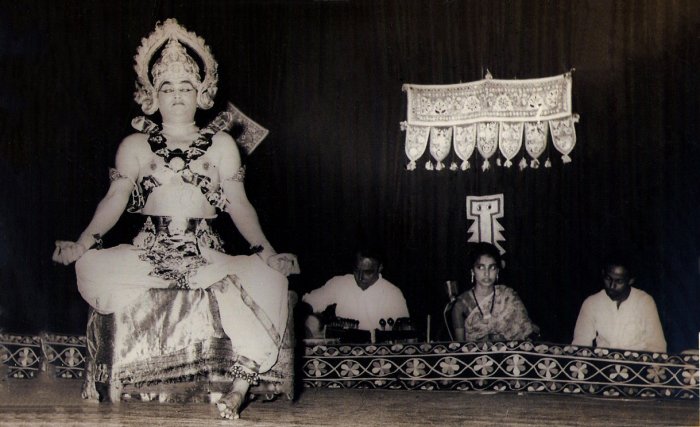 Yog Sunder as Arjuna 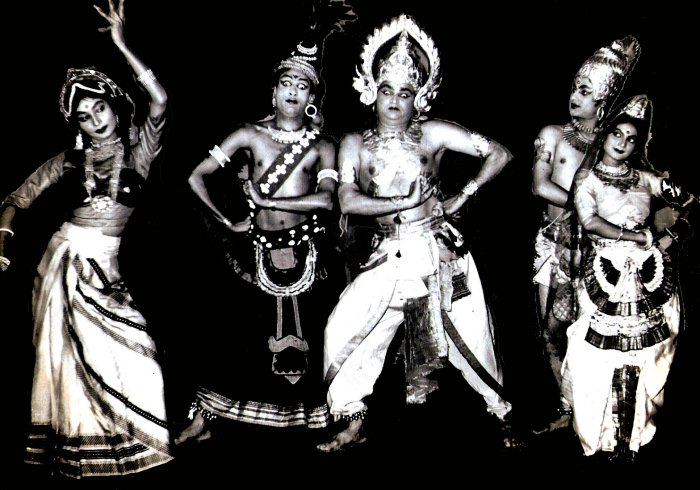 Yog Sunder as Arjuna in Kiratarjun He has produced and directed many well reputed dance productions. Prominent among them are Birth of Freedom, Freedom Festival, Mahabharata, Voice from Beyond, Dances of India, Rhythms of India, Kiratarjun, Chandalika, Call of the Country, Rhythms and Melody, Ramlila, The Lore of India, The Man Divine, Paridhan, Shyama, The Journey, Darkness at Noon, Ram Katha, Festivals of India, Shakuntala, Ekoham Bhahusyam, Yama Parajay, and Harmony. Sangeet Natak Akademi Archives has documented many of his productions. Yog Sunder has also written widely on Indian Art in the name of 'Yogendra Priyadarshi'. His series of articles on Natya Shastra in Gujarati Art magazine 'Kumar' from 1946 to 1950 won him a lot of appreciation for its authenticity. Yog Sunder devoted his life to the preservation and propagation of India's rich cultural heritage - its folk and classical dance forms, regional music and costume, mythology and literature. He researched, revived and showcased a rich variety of dance forms of India since the early days of Independent India, when little was known about these dance forms. Influenced by Gandhian principles, Yog Sunder carried on his work all these years selflessly without chasing wealth and fame. He ran the Group self-supported, without grants and donations, for the major part of its career of seven decades. He unwaveringly remained an idealistic and dedicated artiste who took to Indian dance not as a profession but as a mission.  Yog Sunder receiving Sangeet Natak Akademi Award from President of India Yog Sunder has enriched the cultural landscape of India, at home and abroad, by his selfless service and contribution to furthering Indian Arts. He was awarded the prestigious Sangeet Natak Akademi Puruskar for his lifetime contribution to the field of dance. He is the only Gujarati male dancer to have received this award. Yog Sunder served the cause of Indian dance and for that he stands celebrated. A rich and extraordinary canvas of Life. A Life in Dance. A Century of Life and Dance. 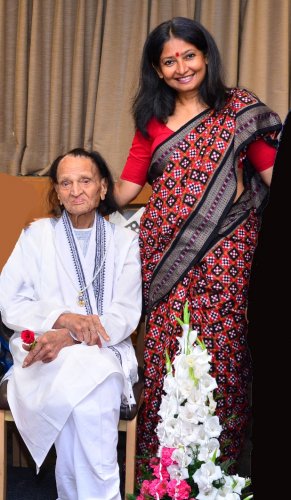 Yog Sunder with daughter Papiha Desai A multitalented dancer and choreographer, Papiha Desai has created a remarkable body of choreographic work in the last 2 decades. Papiha has received intensive training in traditional dance forms of India under great masters. She currently heads the Indian Revival Group, a premier dance ensemble of the country with a career spanning 7 decades, founded by her father, celebrated choreographer Yog Sunder Desai. Post your comments Please provide your name and email id along with your comment. All appropriate comments posted with name and email id in the blog will also be featured in the site. |